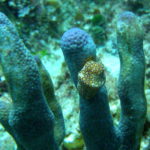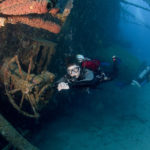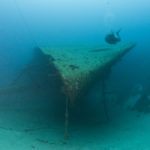It happened during one of those perfect diving moments: it was a bright, clear day on Bonaire. Visibility extended to 80-plus (24 m) feet. The sun penetrated into the shallow water, dappling the coral with splashes of light. Schools of brilliantly colored grunts, blue tangs and black durgons (triggerfish) swirled around me. Here, on a section of the reef called Rappel, the French angelfish and queen parrotfish were abundant. I felt like I had somehow been transported to the world of a Disney cartoon. That’s when it struck me. Bonaire was a kind of time machine, offering divers a chance to experience what Caribbean reefs were like 50 years ago. The best dive sites in Bonaire still offer visitors that feeling.
Bonaire’s reefs aren’t pristine by accident. When few were thinking of underwater conversation in the 1960s, Captain Don Stewart decided this reef was something special, so he and others lobbied for a ban on spear fishing. In the years that followed, others worked to have the entire reef set aside as a national marine park. By 1979, Bonaire passed a law to protect the reef. Visiting divers are now required to get a $25 tag, good for one year of admission, from the national park agency. This you’ll to affix upon their BCD showing that they’ve paid park dues. Bonaire’s reefs are in such good shape, in fact, that the National Oceanic and Atmospheric Administration (NOAA) uses them as the benchmark for healthy reefs in the Caribbean.
Diving here is some of the easiest you’ll ever do — the entire island is geared toward getting you into the water. Rental pickup trucks have tank racks (and some resorts feature drive-through tank delivery). Yellow-painted roadside stones show the location of each dive site: simply park the truck, gear up, and walk in. Given how easy it is to dive here, it’s considerably harder to narrow down the best dive sites in Bonaire. Below we share our favorites. If we’ve left yours out, let us know and we’ll be sure to dive it the next time we’re on the island.
North of Kralendijk
Oil Slick Leap
The fun on this dive starts with the entry. For the moderately brave, there’s a chance to giant stride off a cliff that drops about 10 feet right into the water. It’s perfectly safe — the water underneath is 20 feet deep. The faint of heart can use a ladder, which you’ll also use to exit. The reef here could have been created by the master of fairy tales, Hans Christian Andersen. Coral castles appear periodically along the reef as you head south — stacks of sheet and pillar coral that have swelled to heights of 30-plus feet, looking vaguely like they’ve been built by gnomes from tree stumps and toadstools. Flitting in among the gnome castles, thousands of tiny, colorful reef fish complete the fairyland illusion.
Rappel
One of the northern sites not reachable via shore, Rappel is worth a visit by boat. A shallow plateau (20 to 30 feet) extends out from a rugged cliff on shore, and great light penetration means great color. I’ve never seen a lot of large sea life at this site, but take your time to swim around and look for the impressive macro life for which Bonaire is known. By moving slowly across the reef or even hanging in one spot, I’ve spotted frogfish, seahorses and filefish. Keep an eye out for pretty little juvenile spotted drums, swimming around outside their lairs.
1,000 Steps
Despite the name, it’s not 1,000 steps down to this dive site, (although it will feel like that many on the way up). It’s only 64 and quite manageable even if you’re only in moderately good shape. The site itself is absolutely worth the work of hauling your gear down to the beach. Once you determine which way the current is running, swim into it until you’ve got to turn. Look for large brain coral, a number of massive grouper and lots of sizable rainbow parrotfish.





South of Kralendijk
Angel City
This one’s a Bonaire classic, and a great place to experience the double reef that distinguishes the coast south of Kralendijk, the island capital. There’s an inshore reef in about 30 feet (10 m) of water, followed by a separation of about 40 to 60 feet (12 to 18 m) of sand and then a second reef in deeper water at about 60 feet. On a typical dive, you’ll descend on the outer reef for the outbound leg and then hook around and follow the inner reef for the return. Keep an eye on the sandy stretches for stingrays and the occasional eagle ray.
Hilma Hooker
The drug-smuggling vessel Hilma Hooker famously went down after being detained at the Town Pier in 1984. A large freighter, it eventually sank in relatively deep water as it was being towed to an anchorage. At 90 feet, it’s more of an intermediate dive. You can reach it by boat or from shore, but visiting via shore means a bit of a swim out to the wreck. If you access the site via shore, you’ll swim along a gradual slope of coral before plunging down a wall to finally get to the wreck. Some nice coral along the way makes the trip interesting. There’s something grand about the Hilma Hooker, and good visibility will allow you to see the entire length of the wreck, which seems to stretch out forever at 236 feet (72 m) long. A quick peek into the cargo holds may reveal schools of tarpon.
The Salt Pier
Salt Pier is one of the island’s most popular sites, and it’s easy to see why. There’s an easy shore entry; it’s not too deep, between 15 and 50 feet, (4.5 to 15 m); and there’s tons of sea life hiding among and swimming through the pylons that support the pier. Take your time and look for the plentiful macro life that lives among the coral and sponges that encrust the pylons. If you’re not a macro hunter, never fear — the pier seems to attract a lot of large fish, too, including barracuda and tarpon, and a seemingly ever-present school of grunts swirling around the area. Salt Pier is perfect for photographers who want to incorporate the pylons, and there’s some very cool scenery on the shore as well, piles of white salt surrounded by pink salt flats.





Klein Bonaire
Although almost all of Bonaire’s dives are accessible via shore, the tiny, uninhabited island of Klein Bonaire sits about a mile off the west coast and is worth a visit by boat.
Sampler
On an island of fairytale dive sites, Sampler is perhaps the most surreal. Diving here is reminiscent of a misty morning in the Arizona desert: tube sponges replace cactus; soft coral replaces tumbleweed; coral heads replace the granite hillsides of the desert. True to its name, Sampler offers a bit of everything — seahorses, sea turtles, delicate golden spotted eels. Expect to spend your whole dive surrounded by a swirling mass of black durgon.
The Forest
Visit the forest for what amounts to a 2-for-1. The boat will drop you off at this wall and then you’ll do a comfortable drift dive to the site immediately west, Southwest Corner. Both these sites are adjacent to the open water and that means lots of large barracuda and turtles. Morays and reef fish are plentiful as well. Watch the current as you get close to Southwest Corner, as it picks up speed.
The East Side
Most of Bonaire’s dive sites are on the western (or leeward) side of the island, but the so-called “wild” east side has a few worthy sites of its own. For many years, operators ignored the east side entirely, as a constant wind blowing in from the southeast creates significant waves and swells. All that changed when Larry Baillie bought a solid-hulled Zodiac that could handle any waves the east side could create. Frankly, you feel a bit like a Navy Seal heading out in Larry’s boat. During our first dive on Larry’s Reef, we saw eight large turtles and half dozen large stingrays.
White Hole
This, the east side’s most famous dive site, amounts to large underwater amphitheater. Expect lots of tarpon to be swimming about. If you hang in the water and let the swell carry you, you’ll get within a few feet of these medieval-looking fish. On our last dive here, we passed a section of the reef where an enormous school of blue chromis surged in and out of the coral. It looked as if someone had kicked an anthill as the small fish boiled around the reef in the tens of thousands. At the end of the day, the east side may require a little more effort than the rest of the island, but it’s well worth it.
One small note — the Town Pier is now off limits to divers. This is a shame, as it has been consistently rated as one of the best night dives in the Caribbean — think “Blade Runner” meets “Finding Nemo.” It’s a world that features an ongoing struggle between the cast-offs of a working dock and the unceasing activity of a coral reef. Tires and broken bits of machinery compete with delicate sponges and golden corals. Frogfish inhabit lofty perches on the pylons; seahorses hang from old bits of metal and rubber; and spotted and moray eels have taken up residence in broken bits of concrete blocks. If the site ever opens up again, it’s a must do.
The post The Best Dive Sites in Bonaire appeared first on Scuba Diver Life.
from Scuba Diver Life http://ift.tt/2aDSnds